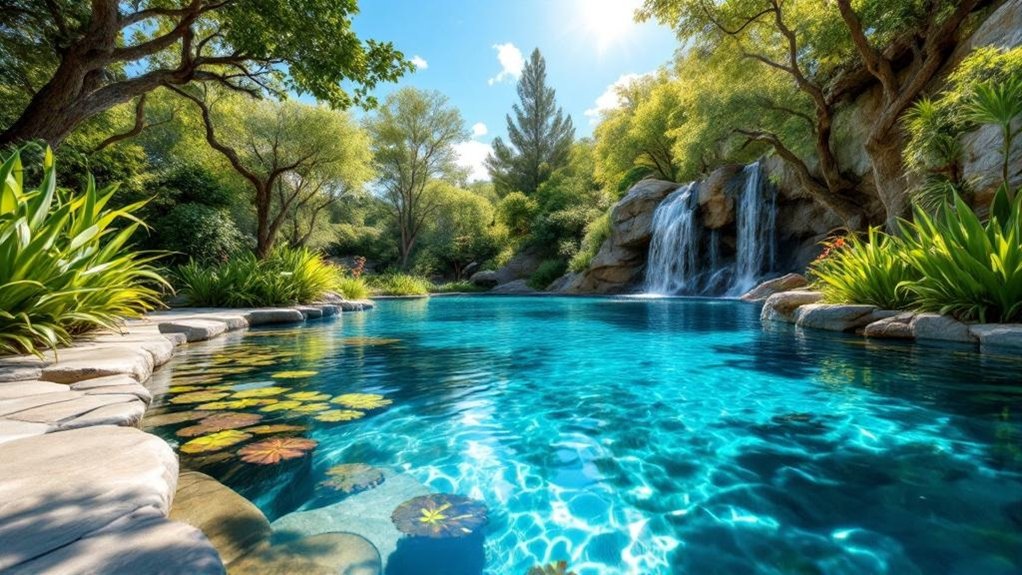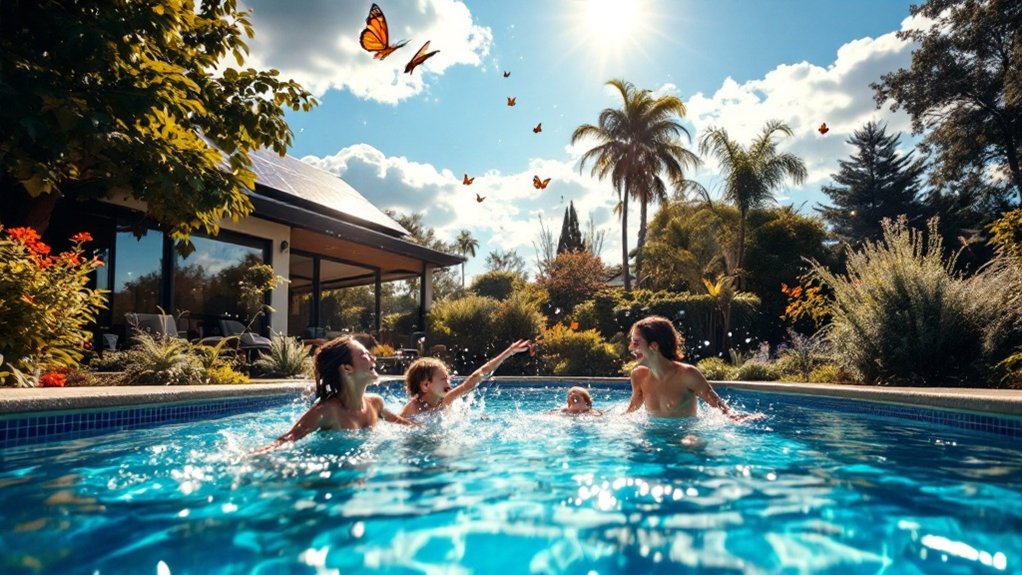Natural pools represent a growing trend in sustainable swimming options. They offer a unique blend of ecological benefits and aesthetic appeal. Utilizing natural filtration systems, these pools provide a chemical-free environment for swimming. Homeowners often appreciate their ability to enhance local biodiversity. However, several factors must be considered when integrating a natural pool into a landscape. Understanding these elements can lead to more informed choices. What should one keep in mind when exploring this eco-friendly option?
What Is a Natural Pool?
A natural pool, often described as an eco-friendly alternative to traditional swimming pools, utilizes a biological filtration system to maintain water clarity and quality. These pools employ a combination of plants and microorganisms to filter and purify the water, eliminating the need for harsh chemicals. Typically designed with a swimming area and a regeneration zone, the latter supports aquatic plants that contribute to water cleanliness. The aesthetic appeal of natural pools often mimics natural bodies of water, incorporating stones, gravel, and vegetation. This design not only enhances the visual landscape but also promotes biodiversity. Unlike conventional pools, natural pools offer a more harmonious integration with the environment, providing a sustainable swimming experience that aligns with eco-conscious values.
Benefits of Natural Pools
Natural pools offer a chemical-free swimming experience that promotes a healthier environment for users. Additionally, they enhance local wildlife habitats, providing a sanctuary for various species. Their design seamlessly integrates with the landscape, contributing to the aesthetic appeal of outdoor spaces.
Chemical-Free Swimming Experience
While many traditional swimming pools rely on harsh chemicals to maintain clean water, a growing number of homeowners are choosing natural pools for a healthier swimming experience. These eco-friendly alternatives use biological filtration systems to keep water clean without synthetic additives. The absence of chlorine and other chemicals means a gentler experience for the skin and eyes, reducing irritation and allergic reactions. Swimmers often report feeling revitalized after a dip in natural pools, as the water is typically warmer and more inviting. Additionally, natural pools offer a tranquil environment, promoting relaxation and well-being. By embracing a chemical-free swimming experience, individuals contribute to a sustainable lifestyle while enjoying the physical and mental health benefits associated with swimming in cleaner, natural water.
Wildlife Habitat Enhancement
Chemical-free pools not only provide a healthier swimming experience but also serve as a valuable habitat for local wildlife. These natural pools foster biodiversity by attracting a variety of species, including amphibians, birds, and beneficial insects. The absence of harmful chemicals creates a safe environment for these creatures, promoting their reproduction and survival. Native plants, often introduced in the landscaping of natural pools, provide essential food sources and shelter, further enhancing habitat quality. Additionally, the presence of water can encourage migratory birds to visit, enriching local ecosystems. By integrating natural elements, these pools not only benefit human users but also contribute to the conservation of local wildlife, making them a key component in sustainable landscaping practices.
Aesthetic Landscape Integration
Aesthetic landscape integration is a significant advantage of pools designed with ecological principles in mind. Natural pools harmoniously blend into their surroundings, enhancing the overall beauty of the landscape. By utilizing native plants and natural materials, these pools create a seamless connection between water and land, promoting a visually appealing environment. The incorporation of natural elements not only adds to the aesthetic value but also fosters a serene atmosphere that encourages relaxation and enjoyment. Additionally, these pools can increase property values by transforming ordinary backyards into stunning retreats. Overall, aesthetic landscape integration elevates the experience of natural swimming pools, making them a desirable choice for homeowners seeking both functionality and beauty in their outdoor spaces.
Design Considerations
When designing sustainable swimming pools, various factors must be taken into account to guarantee environmental responsibility and efficiency. The selection of location is vital; ideal placement can maximize sunlight exposure and minimize energy consumption. Pool shape and size should align with the intended use while ensuring minimal disruption to the surrounding ecosystem. The choice of materials is also significant; utilizing locally sourced, sustainable options can reduce the carbon footprint. Incorporating natural filtration systems, such as aquatic plants, enhances water quality without harmful chemicals. Additionally, integrating renewable energy sources, like solar heating, can further promote sustainability. Attention to landscaping is essential, ensuring that native plants surround the pool, creating a harmonious environment and encouraging biodiversity.
Maintenance Tips for Natural Pools
Maintaining natural pools requires a thoughtful approach to guarantee water quality and ecological balance. Regular monitoring of water parameters, such as pH, alkalinity, and nutrient levels, is essential to prevent algae blooms. Natural filtration systems, often comprised of aquatic plants and gravel, should be kept clean and free of debris to function effectively. Additionally, periodic removal of fallen leaves and organic matter will help maintain clarity and reduce organic decay. It is also advisable to inspect and maintain pump systems and aerators regularly, ensuring they operate efficiently. To support biodiversity, introducing beneficial microorganisms can enhance the ecosystem’s health. Finally, seasonal maintenance tasks, such as winterizing the pool, should not be overlooked to protect the natural balance throughout the year.
Environmental Impact
The environmental impact of swimming pools is a considerable consideration in the pursuit of sustainable aquatic leisure. Traditional pools often require substantial water use, chemical treatments, and energy for heating and filtration, leading to adverse effects on local ecosystems and increased carbon footprints. In contrast, natural pools utilize biological filtration systems, reducing reliance on synthetic chemicals and minimizing environmental harm. These systems promote biodiversity, attracting beneficial wildlife while providing a habitat for various species. Additionally, natural pools typically use less water by embracing a more sustainable design that incorporates rainwater harvesting and efficient circulation. Overall, adopting natural pools can meaningfully mitigate the ecological footprint associated with traditional swimming facilities, fostering a more harmonious relationship between leisure and nature.
Aesthetic Appeal of Natural Pools
Natural pools not only contribute to ecological sustainability but also offer a unique aesthetic appeal that enhances outdoor spaces. Their organic design harmonizes with nature, often resembling serene ponds found in the wild. Featuring natural materials like stone and wood, these pools blend seamlessly into the landscape, creating a tranquil retreat. The incorporation of aquatic plants and native flora adds vibrant colors and textures, attracting wildlife and enriching the environment. Additionally, the absence of harsh chemicals allows for a more natural swimming experience, promoting a sense of well-being. The gentle curves and varying depths of natural pools encourage creativity in design, making them a stunning focal point for gardens and backyards alike. Overall, their beauty elevates both the visual and experiential quality of outdoor living.
Frequently Asked Questions
Can I Install a Natural Pool in Any Climate?
The feasibility of installing a natural pool in various climates depends on factors like local regulations, temperature ranges, and vegetation. While possible in many areas, specific adaptations may be necessary to guarantee proper functionality and maintenance.
How Deep Should a Natural Pool Be?
The depth of a natural pool typically ranges from three to six feet. This depth guarantees adequate water circulation and supports aquatic life, while also providing a safe swimming environment for users of various ages and abilities.
Are Natural Pools Safe for Children and Pets?
The safety of natural pools for children and pets depends on design and maintenance. Properly constructed pools with shallow areas and clear boundaries can provide safe environments, but supervision remains essential to prevent accidents.
What Plants Are Best for Natural Pools?
The best plants for natural pools include aquatic varieties like water lilies, cattails, and rushes. These plants enhance water quality, provide habitat for wildlife, and contribute to the overall aesthetic and ecological balance of the pool environment.
How Much Does It Cost to Build a Natural Pool?
The cost to build a natural pool varies considerably, typically ranging from $50 to $150 per square foot. Factors influencing expenses include design complexity, materials, size, and regional labor costs, impacting overall investment requirements.
Conclusion
To sum up, natural pools represent a harmonious blend of sustainability and beauty, offering a chemical-free swimming experience while enhancing local biodiversity. Their eco-friendly design and low maintenance requirements make them an appealing choice for environmentally conscious homeowners. As more people seek sustainable alternatives, natural pools emerge as a viable option for those looking to enjoy the benefits of swimming while preserving the environment. Ultimately, they promote a lifestyle that prioritizes both relaxation and ecological responsibility.




